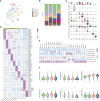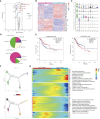Dissecting the Single-Cell Transcriptome Network of Immune Environment Underlying Cervical Premalignant Lesion, Cervical Cancer and Metastatic Lymph Nodes
- PMID: 35812401
- PMCID: PMC9263187
- DOI: 10.3389/fimmu.2022.897366
Dissecting the Single-Cell Transcriptome Network of Immune Environment Underlying Cervical Premalignant Lesion, Cervical Cancer and Metastatic Lymph Nodes
Erratum in
-
Corrigendum: Dissecting the single-cell transcriptome network of immune environment underlying cervical premalignant lesion, cervical cancer and metastatic lymph nodes.Front Immunol. 2024 Feb 23;15:1386072. doi: 10.3389/fimmu.2024.1386072. eCollection 2024. Front Immunol. 2024. PMID: 38464538 Free PMC article.
Abstract
Cervical cancer (CC) is one of the most common malignancy in women worldwide. It is characterized by a natural continuous phenomenon, that is, it is in the initial stage of HPV infection, progresses to intraepithelial neoplasia, and then develops into invasion and metastasis. Determining the complexity of tumor microenvironment (TME) can deepen our understanding of lesion progression and provide novel therapeutic strategies for CC. We performed the single-cell RNA sequencing on the normal cervix, intraepithelial neoplasia, primary tumor and metastatic lymph node tissues to describe the composition, lineage, and functional status of immune cells and mesenchymal cells at different stages of CC progression. A total of 59913 single cells were obtained and divided into 9 cellular clusters, including immune cells (T/NK cells, macrophages, B cells, plasma cells, mast cells and neutrophils) and mesenchymal cells (endothelial cells, smooth muscle cells and fibroblasts). Our results showed that there were distinct cell subpopulations in different stages of CC. High-stage intraepithelial neoplasia (HSIL) tissue exhibited a low, recently activated TME, and it was characterized by high infiltration of tissue-resident CD8 T cell, effector NK cells, Treg, DC1, pDC, and M1-like macrophages. Tumor tissue displayed high enrichment of exhausted CD8 T cells, resident NK cells and M2-like macrophages, suggesting immunosuppressive TME. Metastatic lymph node consisted of naive T cell, central memory T cell, circling NK cells, cytotoxic CD8+ T cells and effector memory CD8 T cells, suggesting an early activated phase of immune response. This study is the first to delineate the transcriptome profile of immune cells during CC progression using single-cell RNA sequencing. Our results indicated that HSIL exhibited a low, recently activated TME, tumor displayed immunosuppressive statue, and metastatic lymph node showed early activated phase of immune response. Our study enhanced the understanding of dynamic change of TME during CC progression and has implications for the development of novel treatments to inhibit the initiation and progression of CC.
Keywords: cervical cancer; immune cell; single-cell sequencing; squamous cell carcinoma; tumor microenvironment.
Copyright © 2022 Li and Hua.
Conflict of interest statement
The authors declare that the research was conducted in the absence of any commercial or financial relationships that could be construed as a potential conflict of interest.
Figures








Similar articles
-
Integrated single-cell transcriptome analysis of the tumor ecosystems underlying cervical cancer metastasis.Front Immunol. 2022 Dec 9;13:966291. doi: 10.3389/fimmu.2022.966291. eCollection 2022. Front Immunol. 2022. PMID: 36569924 Free PMC article.
-
Spatiotemporally deciphering the mysterious mechanism of persistent HPV-induced malignant transition and immune remodelling from HPV-infected normal cervix, precancer to cervical cancer: Integrating single-cell RNA-sequencing and spatial transcriptome.Clin Transl Med. 2023 Mar;13(3):e1219. doi: 10.1002/ctm2.1219. Clin Transl Med. 2023. PMID: 36967539 Free PMC article.
-
Elucidating the role of tumor-associated ALOX5+ mast cells with transformative function in cervical cancer progression via single-cell RNA sequencing.Front Immunol. 2024 Aug 19;15:1434450. doi: 10.3389/fimmu.2024.1434450. eCollection 2024. Front Immunol. 2024. PMID: 39224598 Free PMC article.
-
Infiltration Patterns of Cervical Epithelial Microenvironment Cells During Carcinogenesis.Front Immunol. 2022 Jul 14;13:888176. doi: 10.3389/fimmu.2022.888176. eCollection 2022. Front Immunol. 2022. PMID: 35911729 Free PMC article. Review.
-
The immune microenvironment in vulvar (pre)cancer: review of literature and implications for immunotherapy.Expert Opin Biol Ther. 2018 Dec;18(12):1223-1233. doi: 10.1080/14712598.2018.1542426. Epub 2018 Nov 2. Expert Opin Biol Ther. 2018. PMID: 30373410 Review.
Cited by
-
Targeting CDCP1 boost CD8+ T cells-mediated cytotoxicity in cervical cancer via the JAK/STAT signaling pathway.J Immunother Cancer. 2024 Oct 24;12(10):e009416. doi: 10.1136/jitc-2024-009416. J Immunother Cancer. 2024. PMID: 39455095 Free PMC article.
-
Targeting HPV for the prevention, diagnosis, and treatment of cervical cancer.J Mol Cell Biol. 2025 May 2;16(10):mjae046. doi: 10.1093/jmcb/mjae046. J Mol Cell Biol. 2025. PMID: 39402008 Free PMC article. Review.
-
Single-nucleus RNA sequencing and deep tissue proteomics reveal distinct tumour microenvironment in stage-I and II cervical cancer.J Exp Clin Cancer Res. 2023 Jan 23;42(1):28. doi: 10.1186/s13046-023-02598-0. J Exp Clin Cancer Res. 2023. PMID: 36683048 Free PMC article.
-
Impact of lymphadenectomy extent on immunotherapy efficacy in postresectional recurred non-small cell lung cancer: a multi-institutional retrospective cohort study.Int J Surg. 2024 Jan 1;110(1):238-252. doi: 10.1097/JS9.0000000000000774. Int J Surg. 2024. PMID: 37755384 Free PMC article.
-
Correlation study of serum lipid levels and lipid metabolism-related genes in cervical cancer.Front Oncol. 2024 May 8;14:1384778. doi: 10.3389/fonc.2024.1384778. eCollection 2024. Front Oncol. 2024. PMID: 38779100 Free PMC article.

